Materials Optimization and Service Performance Evaluation of a Novel Steel Bridge Deck Pavement Structure: A Case Study
Abstract
:1. Introduction
2. Background of the Trial Road
3. Materials and Methods
3.1. Raw Materials
3.2. Mixing Parameters
3.3. Mixture Preparation and Design
4. Test and Evaluation Methods
4.1. Laboratory Binder Performance Test
4.2. Laboratory Concrete Performance Test
4.3. Service Performance Evaluation
5. Results and Discussion
5.1. Mechanical Property and Viscosity Characteristics of the ESA Binder
5.2. High-Temperature Rutting Resistance
5.3. Low-Temperature Crack Resistance
5.4. Moisture Damage Resistance
5.5. Skid Resistance
5.6. Service Performance of the Trial Section
6. Conclusions
- (a)
- Using SBS-modified asphalt binder as the asphalt matrix helped to improve the strength and toughness of the ESA binder simultaneously. The increase in EP content enhanced the mechanical strength of the ESA binder but tended to affect the toughness negatively. Additionally, the construction allowable time for the ESA binder was sufficient and exceeded 150 min.
- (b)
- ESAC and HSAC had good pavement performance; only the high-temperature performance of HSAC7 and the low-temperature performance of ESAC50 failed to meet the specification requirements. The optimal content of TPS in HAS binder and EP in the ESA binder were finally determined to be 11 wt% and 45 wt%, respectively.
- (c)
- The εB and BPN of HSAC11 reached 4198 με and 94, and the outstanding low-temperature toughness and skid resistance contributed to the reduction of cracking disease in the top layer whilst improving the comfort and safety of driving. The DS of ESAC45 was 22,360 times/mm, and the excellent high-temperature stability and moisture damage resistance provided a stable pavement base for the top layer. Meanwhile, its satisfactory toughness synergized favorably with the steel plate, which limited the generation of cracks as well as reflective cracks in the bottom layer.
- (d)
- The service condition of the trial road paved with the ERS system was inferior to that of the SMAC + EAC structure. The trial road paved with the ERS system only had one lane with an SDPQI above 90. In contrast, under the higher traffic volume, the SDPQI of all lanes of the trial road using the SMAC + EAC structure reached above 90. The excellent service performance of this novel steel deck pavement structure validated that its application is feasible and has the potential to be replicated.
- (e)
- The service performance of the trial road will continue to be measured in the future to provide further data comparisons and analyses as a basis for promoting the SMAC + EAC structure.
Author Contributions
Funding
Institutional Review Board Statement
Informed Consent Statement
Data Availability Statement
Conflicts of Interest
Abbreviations
| Abbreviations | Unit | Phrases |
| SBDP | / | Steel Bridge Deck Pavement |
| EAC | / | Epoxy Asphalt Concrete |
| GAC | / | Guss Asphalt Concrete |
| SMAC | / | Stone Mastic Asphalt Concrete |
| EA | / | Epoxy Asphalt |
| ECBL | / | Epoxy Bonding Chips Layer |
| RAC | / | Resin Asphalt Concrete |
| EP | / | Epoxy Resin |
| ESA | / | Epoxy SBS Asphalt |
| HSA | / | High-viscosity SBS Asphalt |
| TPS | / | TAFPACK-Super |
| ESAC | / | Epoxy SBS Asphalt Concrete |
| HSAC | / | High-viscosity SBS Asphalt Concrete |
| DS | times/mm | Dynamic Stability |
| εB | με | Maximum Flexural Strain |
| RS | % | Residual Stability |
| TSR | % | Tensile Strength Ratio |
| BPN | / | British Pendulum Number |
| TS | MPa | Tensile Strength |
| EB | % | Elongation at Break |
| SDPCI | / | SBDP Condition Index |
| SDRQI | / | SBDP Riding Quality Index |
| SDRDI | / | SBDP Rutting Depth Index |
| SDPWI | / | SBDP Wearing Index |
| SDPQI | / | SBDP Quality Index |
References
- Sun, J.; Zhang, Z.; Ye, J.; Liu, H.; Wei, Y.; Zhang, D.; Li, X. Preparation and properties of polyurethane/epoxy-resin modified asphalt binders and mixtures using a bio-based curing agent. J. Clean. Prod. 2022, 380, 135030. [Google Scholar] [CrossRef]
- Heng, K.; Jia, P.; Xu, J.; Li, R.; Wu, H. Vehicular impact resistance of highway bridge with seismically-designed UHPC pier. Eng. Struct. 2022, 252, 113635. [Google Scholar] [CrossRef]
- Shao, X.; Deng, L.; Cao, J. Innovative steel-UHPC composite bridge girders for long-span bridges. Front. Struct. Civ. Eng. 2019, 13, 981–989. [Google Scholar] [CrossRef]
- Zhang, Z.; Sun, J.; Huang, Z.; Wang, F.; Jia, M.; Lv, W.; Ye, J. A laboratory study of epoxy/polyurethane modified asphalt binders and mixtures suitable for flexible bridge deck pavement. Constr. Build. Mater. 2021, 274, 122084. [Google Scholar] [CrossRef]
- Liu, Y.; Qian, Z.; Hu, H.; Shi, X.; Chen, L. Developing a skid resistance prediction model for newly built pavement: Application to a case study of steel bridge deck pavement. Road Mater. Pavement Des. 2022, 23, 2334–2352. [Google Scholar] [CrossRef]
- Jia, M.; Zhang, Z.; Yang, N.; Qi, B.; Wang, W.; Huang, Z.; Sun, J.; Luo, F.; Huang, T. Performance Evaluation of Thermosetting and Thermoplastic Polyurethane Asphalt Mixtures. J. Mater. Civ. Eng. 2022, 34, 04022097. [Google Scholar] [CrossRef]
- Liu, Y.; Shen, Z.; Liu, J.; Chen, S.; Wang, J.; Wang, X. Advances in the application and research of steel bridge deck pavement. Structures 2022, 45, 1156–1174. [Google Scholar] [CrossRef]
- Luo, S.; Qian, Z.; Yang, X.; Lu, Q. Laboratory Evaluation of Double-Layered Pavement Structures for Long-Span Steel Bridge Decks. J. Mater. Civ. Eng. 2018, 30, 04018111. [Google Scholar] [CrossRef]
- Luo, S.; Lu, Q.; Qian, Z.; Wang, H.; Huang, Y. Laboratory investigation and numerical simulation of the rutting performance of double-layer surfacing structure for steel bridge decks. Constr. Build. Mater. 2017, 144, 178–187. [Google Scholar] [CrossRef]
- Luo, S.; Qian, Z.; Yang, X.; Wang, H. Design of gussasphalt mixtures based on performance of gussasphalt binders, mastics and mixtures. Constr. Build. Mater. 2017, 156, 131–141. [Google Scholar] [CrossRef]
- Luo, S.; Sun, J.; Hu, J.; Liu, S. Performance Evolution Mechanism of Hot-Mix Epoxy Asphalt Binder and Mixture Based on Component Characteristics. J. Mater. Civ. Eng. 2022, 34, 04022235. [Google Scholar] [CrossRef]
- Zhang, D.; Ye, F.; Yuan, J. Analysis on Steel Bridge Pavement Structure Performance. Procedia-Soc. Behav. Sci. 2013, 96, 2462–2465. [Google Scholar] [CrossRef]
- Chen, L.; Zhao, X.; Qian, Z.; Li, J. A systematic review of steel bridge deck pavement in China. J. Road Eng. 2023, 3, 1–15. [Google Scholar] [CrossRef]
- Tian, J.; Luo, S.; Lu, Q.; Liu, S. Effects of Epoxy Resin Content on Properties of Hot Mixing Epoxy Asphalt Binders. Journal of Mater. Civ. Eng. 2022, 34, 04022145. [Google Scholar] [CrossRef]
- Luo, S.; Liu, Z.; Yang, X.; Lu, Q.; Yin, J. Construction Technology of Warm and Hot Mix Epoxy Asphalt Paving for Long-Span Steel Bridge. J. Constr. Eng. M 2019, 145, 04019074. [Google Scholar] [CrossRef]
- Fan, X.; Luo, R. Experimental study on crack resistance of typical steel-bridge-deck paving materials. Constr. Build. Mater. 2021, 277, 122315. [Google Scholar] [CrossRef]
- Jia, X.; Huang, B.; Chen, S.; Shi, D. Comparative investigation into field performance of steel bridge deck asphalt overlay systems. KSCE J. Civ. Eng. 2016, 20, 2755–2764. [Google Scholar] [CrossRef]
- Hu, D.; Lan, C.; Liang, N.; Wang, M.; Xiao, L. Prediction of Rutting Depth of Steel Bridge Deck Pavement Composite Structure Using Gussasphalt + SMA. China J. Highw. Transp. 2021, 34, 10–18. [Google Scholar] [CrossRef]
- Liu, X.; Zhou, C.; Feng, D.; Fan, X.; Xie, S. Experimental study on interlayer shear properties of ERS pavement system for long-span steel bridges. Constr. Build. Mater. 2017, 143, 198–209. [Google Scholar] [CrossRef]
- Liu, X.; Zhou, C.; Cao, Q.; Chen, L.; Feng, D. Experimental study on properties of epoxy binder and epoxy bonding chips layer for steel bridge deck pavement. Road Mater. Pavement Des. 2022, 23, 2451–2465. [Google Scholar] [CrossRef]
- Chen, L.; Qian, Z.; Chen, D.; Wei, Y. Feasibility Evaluation of a Long-Life Asphalt Pavement for Steel Bridge Deck. Adv. Civ. Eng. 2020, 2020, 5890945. [Google Scholar] [CrossRef]
- Sun, J.; Luo, S.; Huang, W.; Hu, J.; Liu, S. Structural optimization of steel bridge deck pavement based on mixture performance and mechanical simulation. Constr. Build. Mater. 2023, 367, 130217. [Google Scholar] [CrossRef]
- JTG F40-2004; Technical Specification for Construction of Highway Asphalt Pavements. Ministry of Transport of China: Beijing, China, 2004.
- JTG/T3364-02-2019; Specifications for Design and Construction of Pavement on Highway Steel Deck Bridge. Ministry of Transport of China: Beijing, China, 2019.
- Sun, J.; Huang, W.; Lu, G.; Luo, S.; Li, Y. Investigation of the performance and micro-evolution mechanism of low-content thermosetting epoxy asphalt binder towards sustainable highway and bridge decks paving. J. Clean. Prod. 2023, 384, 135588. [Google Scholar] [CrossRef]
- Xie, H.; Li, C.; Wang, Q. A critical review on performance and phase separation of thermosetting epoxy asphalt binders and bond coats. Constr. Build. Mater. 2022, 326, 126792. [Google Scholar] [CrossRef]
- Gong, J.; Liu, Y.; Wang, Q.; Xi, Z.; Cai, J.; Ding, G.; Xie, H. Performance evaluation of warm mix asphalt additive modified epoxy asphalt rubbers. Constr. Build. Mater. 2019, 204, 288–295. [Google Scholar] [CrossRef]
- Zhang, Z.; Chen, L.; Peng, J.; Sun, J.; Zhang, D.; Li, X.; Wen, F.; Liu, H. Preparation and properties of a novel high-viscosity modified bitumen. Constr. Build. Mater. 2022, 344, 128183. [Google Scholar] [CrossRef]
- Kiselev, A.; Zhang, H.; Liu, Z. The effect of two-phase mixing on the functional and mechanical properties of TPS/SBS-modified porous asphalt concrete. Constr. Build. Mater. 2021, 270, 121841. [Google Scholar] [CrossRef]
- Jiao, Y.; Zhang, Y.; Fu, L.; Guo, M.; Zhang, L. Influence of crumb rubber and tafpack super on performances of SBS modified porous asphalt mixtures. Road Mater. Pavement Des. 2019, 20, S196–S216. [Google Scholar] [CrossRef]
- ASTM D638-14; Standard Test Method for Tensile Properties of Plastics. ASTM International: West Conshohocken, PA, USA, 2014.
- ASTM D4402; Standard Test Method for Viscosity Determination of Asphalt at Elevated Temperatures Using a Rotational Viscometer. ASTM International: West Conshohocken, PA, USA, 2015.
- JTG E60-2019; Field Test Methods of Highway Subgrade and Pavement. Ministry of Transport of China: Beijing, China, 2019.
- JTG E20-2011; Highway Engineering Asphalt and Asphalt Mixture Test Regulations. Ministry of Transport of China: Beijing, China, 2011.
- JTG 5210-2018; Highway Performance Assessment Standards. Ministry of Transport of China: Beijing, China, 2018.
- JTG 5210-2018; Technical Specification for Maintenance Technology of Long Span Bridge Steel Deck Epoxy Asphalt Concrete Pavement. Jiangsu Provincial Bureau of Quality and Technical Supervision: Nanjing, China, 2017.
- Sun, J.; Zhang, Z.; Wang, L.; Liu, H.; Ban, X.; Ye, J. Investigation on the epoxy/polyurethane modified asphalt binder cured with bio-based curing agent: Properties and optimization. Constr. Build. Mater. 2022, 320, 126221. [Google Scholar] [CrossRef]
- Zhong, K.; Sun, M.; Chang, R. Performance evaluation of high-elastic/salt-storage asphalt mixture modified with Mafilon and rubber particles. Constr. Build. Mater. 2018, 193, 153–161. [Google Scholar] [CrossRef]
- Jia, M.; Sha, A.; Jiang, W.; Li, X.; Jiao, W. Developing a solid–solid phase change heat storage asphalt pavement material and its application as functional filler for cooling asphalt pavement. Energy Build. 2023, 285, 112935. [Google Scholar] [CrossRef]
- Huang, S.C. Rubber Concentrations on Rheology of Aged Asphalt Binders. J. Mater. Civ. Eng. 2008, 20, 221–229. [Google Scholar] [CrossRef]
- Fwa, T.F. Skid resistance determination for pavement management and wet-weather road safety. Int. J. Transp. Sci. Technol. 2017, 6, 217–227. [Google Scholar] [CrossRef]
- Yu, Y.; Tang, S.; Xu, G.; Fan, Y.; Wu, Y.; Wang, H.; Yang, J. Investigations on the long-term skid resistance of epoxy asphalt mixture based on accelerated loading test. Constr. Build. Mater. 2023, 365, 130150. [Google Scholar] [CrossRef]
- Zeng, G.; Xu, W.; Huang, H.; Zhang, X. Study on the microstructure and properties of hot-mix epoxy asphalt. Int. J. Pavement Res. Technol. 2019, 12, 147–153. [Google Scholar] [CrossRef]

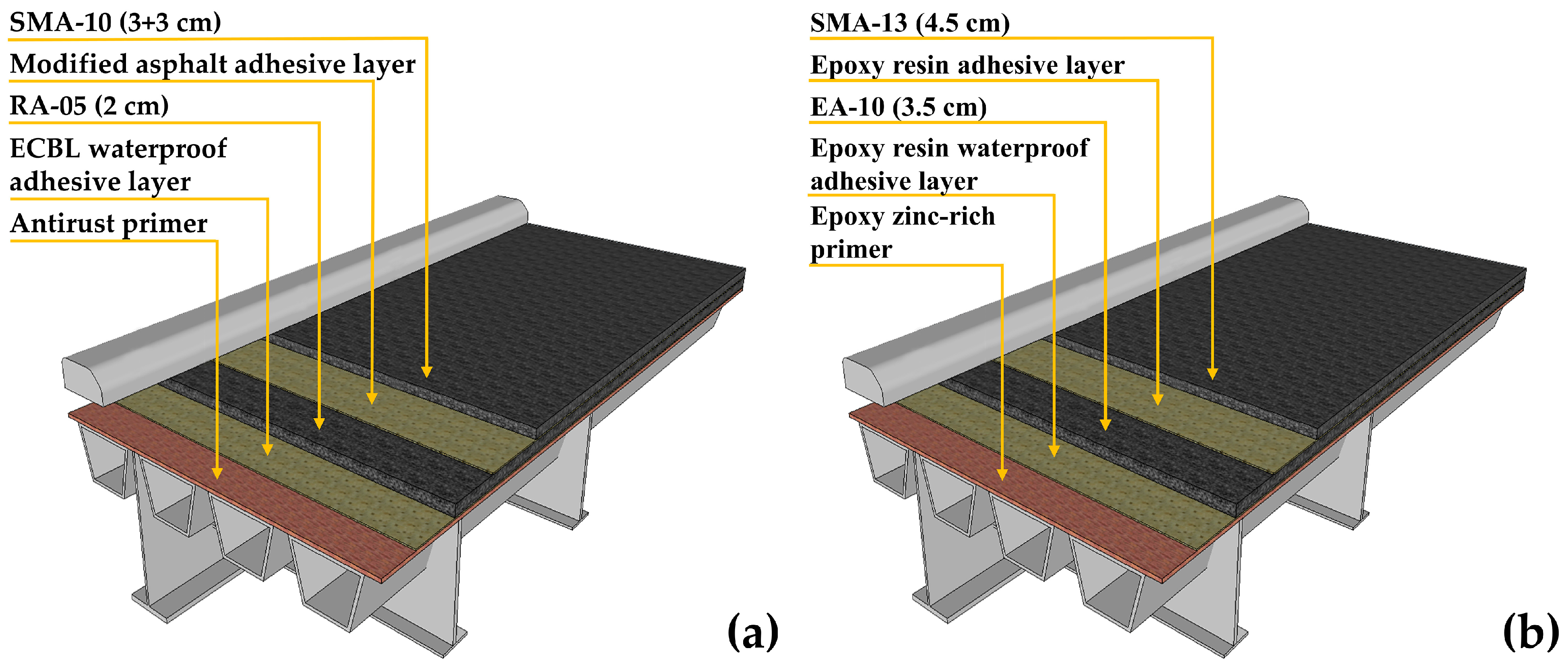
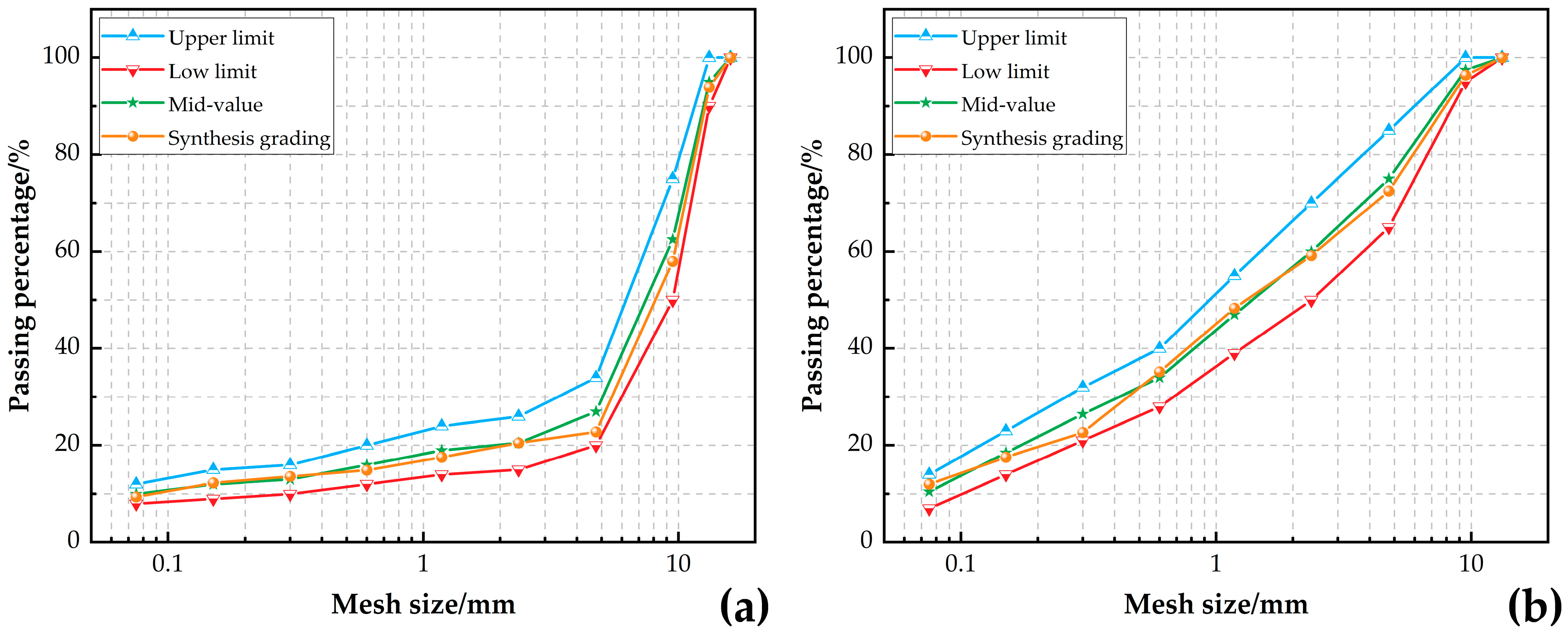
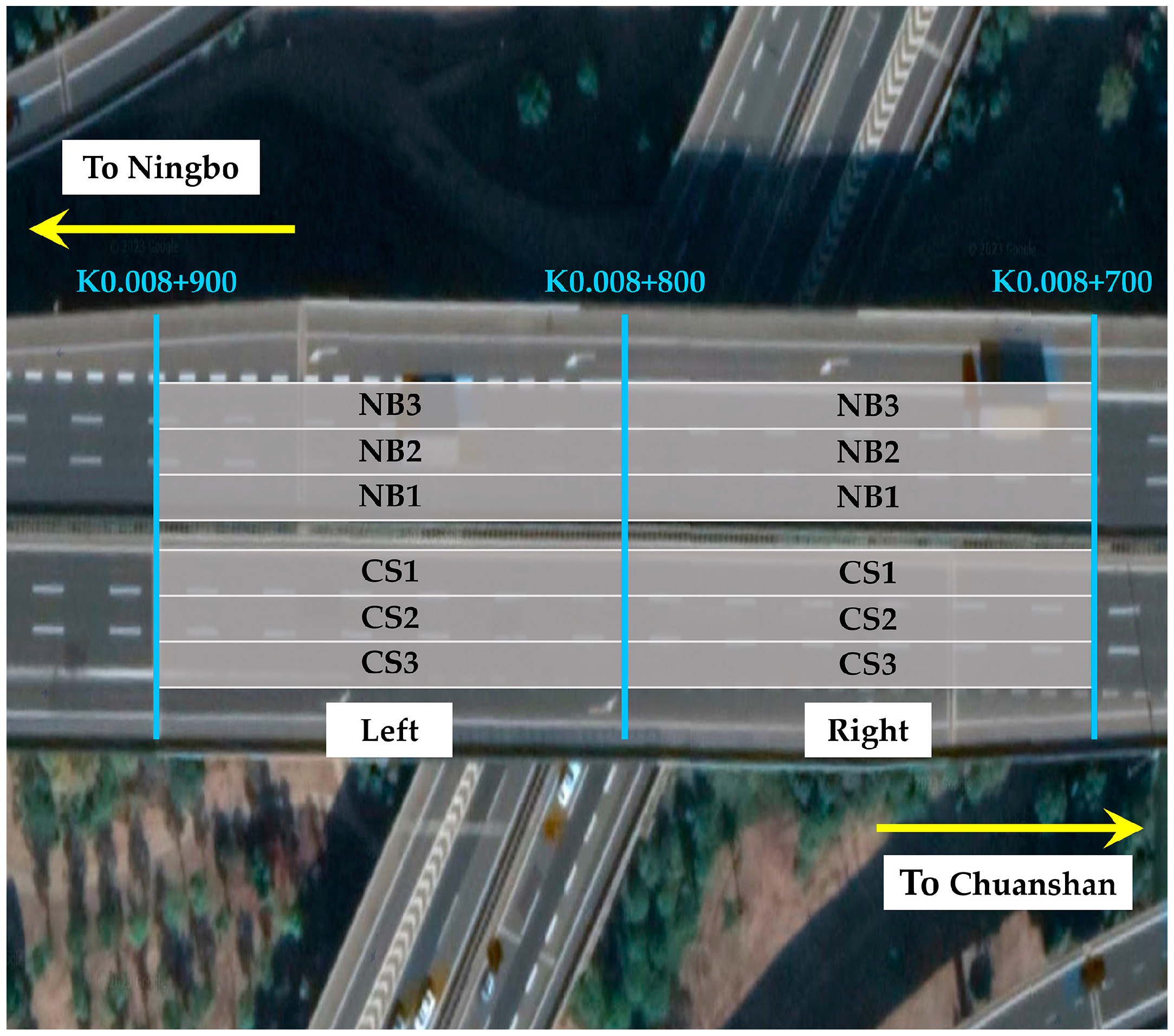



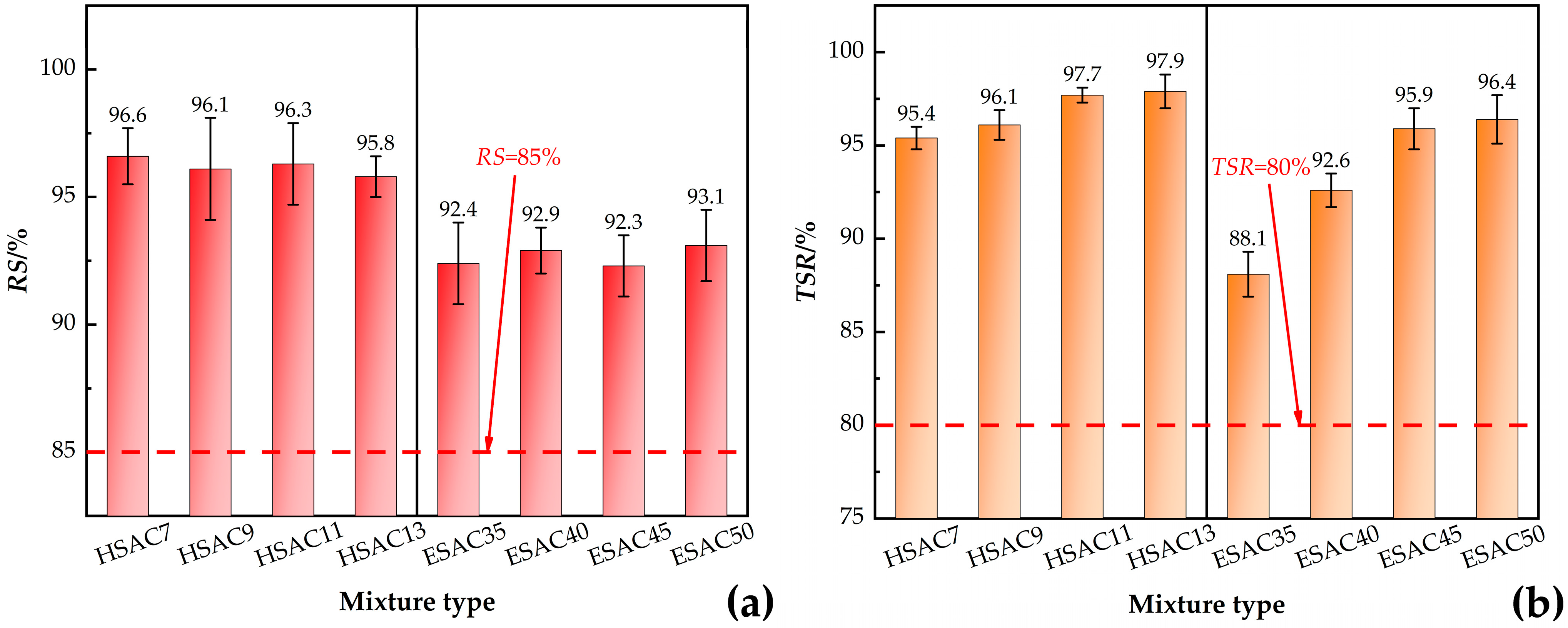
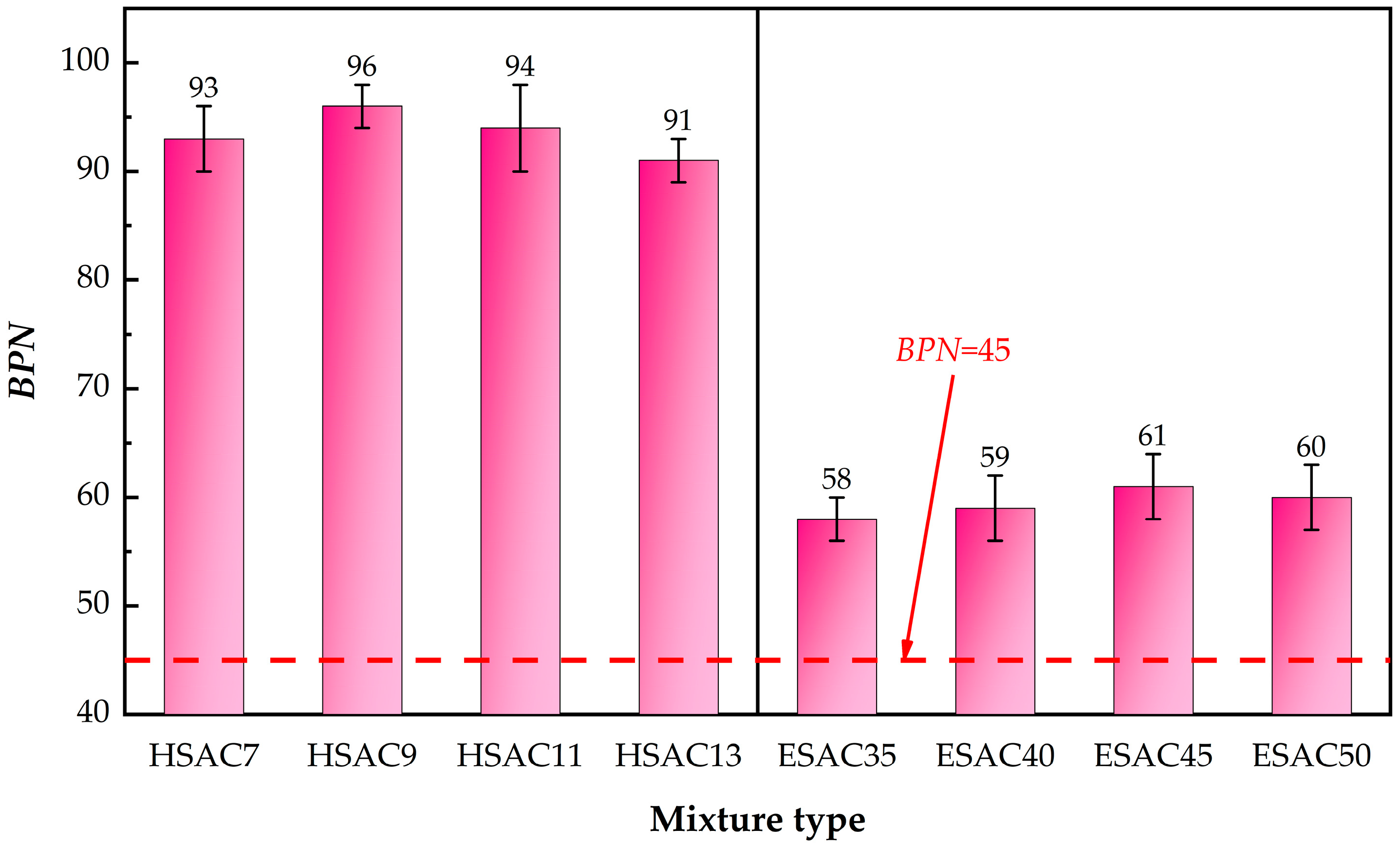

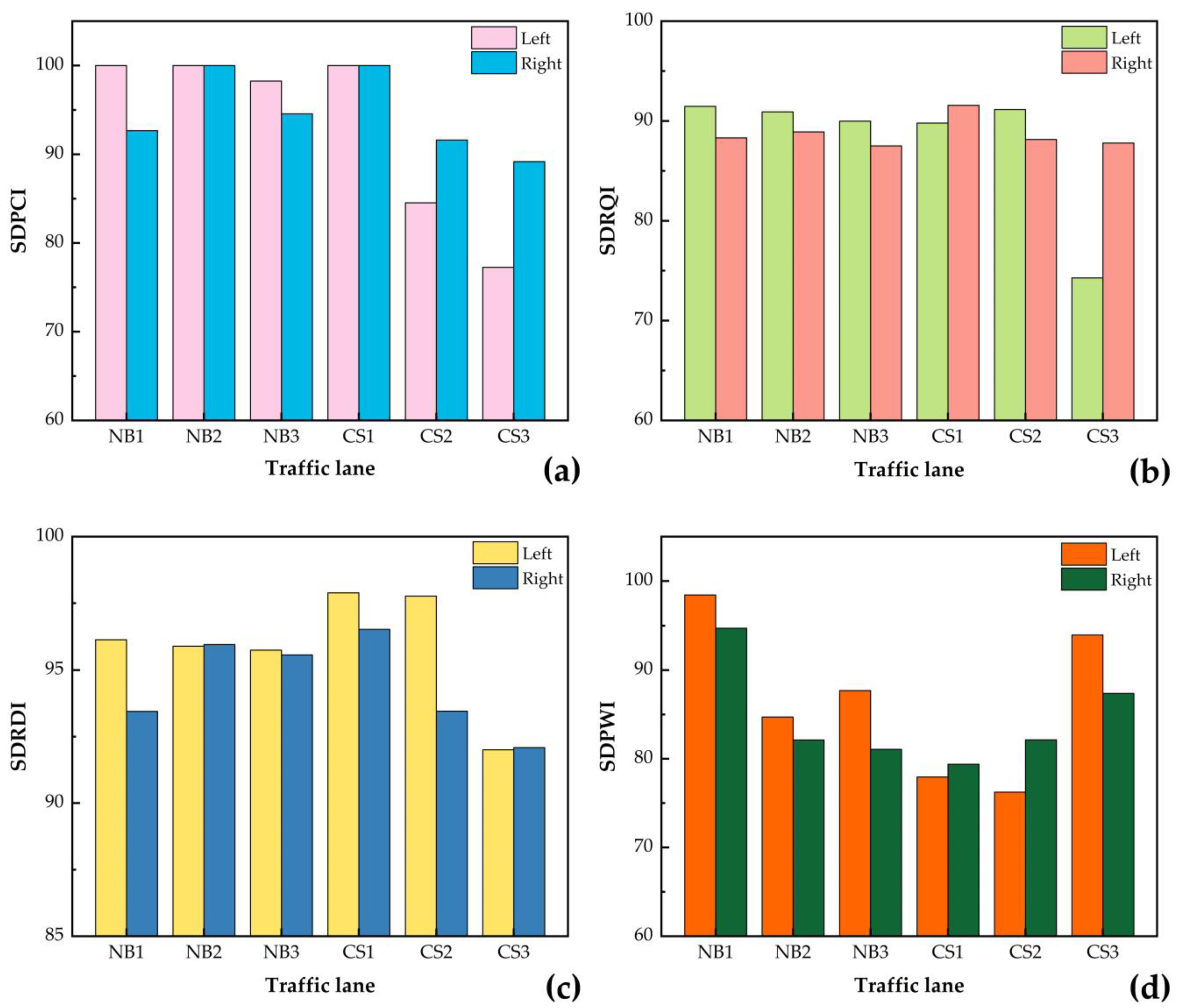

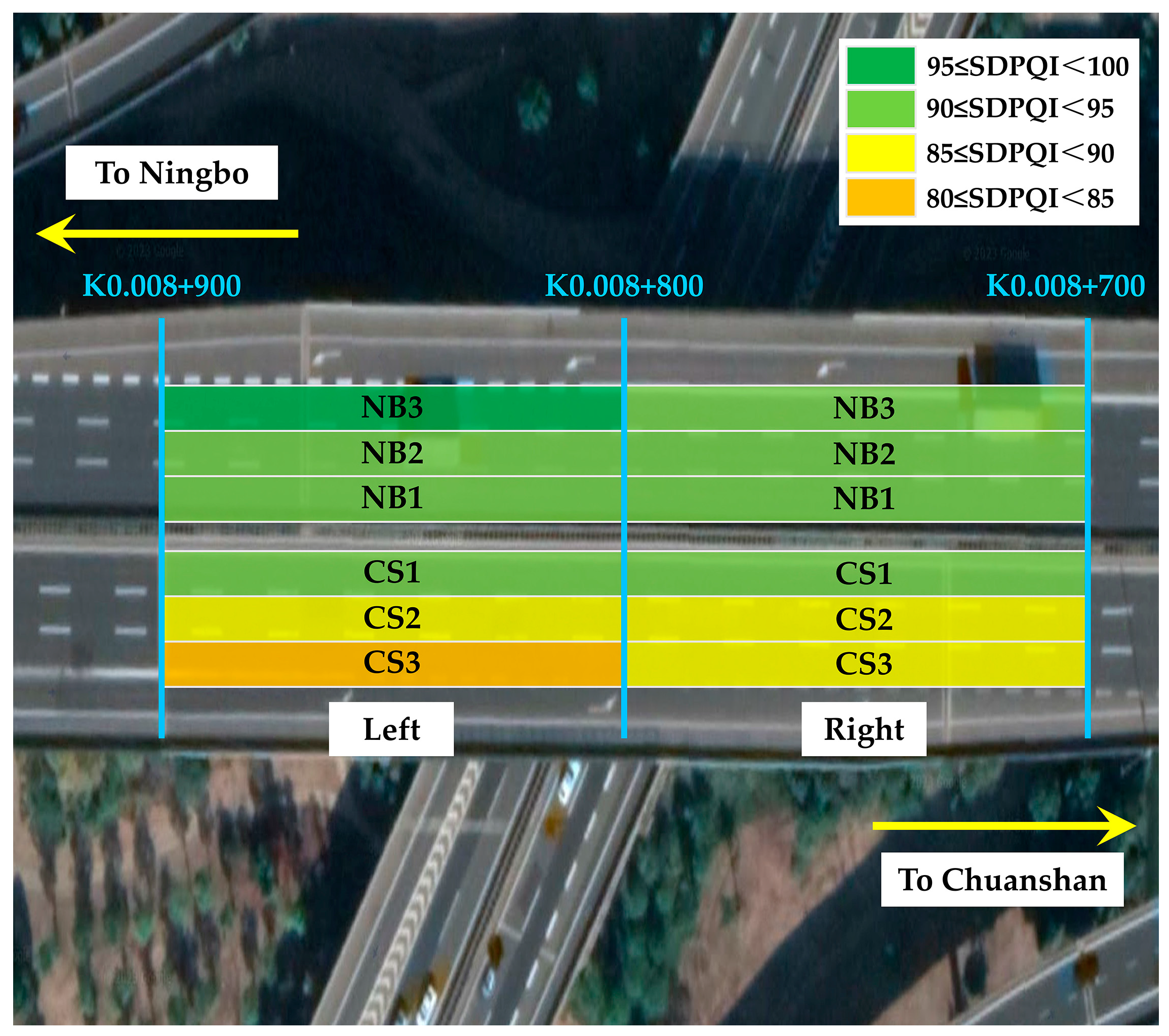
| Technical Index | Unit | Result | Specification | |
|---|---|---|---|---|
| Penetration (25 °C, 100 g, 5 s) | 0.1 mm | 54.4 | 40–60 | |
| Ductility (5 cm/min, 5 °C) | cm | 34 | ≥30 | |
| Softening point | °C | 80.5 | ≥80 | |
| Penetration index | / | 0.76 | ≥0 | |
| Dynamic viscosity (135 °C) | Pa·s | 2.57 | ≤3.0 | |
| Flash point | °C | 291 | ≥230 | |
| Elastic restitution (25 °C) | % | 88 | ≥80 | |
| Solubility | % | 99.5 | ≥99 | |
| Density (15 °C) | g/cm3 | 1.021 | / | |
| RTFOT (163 °C, 5 h) | Mass loss | % | −0.16 | ≤±1.0 |
| Penetration ratio | % | 76 | ≥65 | |
| Ductility (5 °C, 5 cm/min) | cm | 23 | ≥20 | |
| Modifier Type | Basic Performance |
|---|---|
| Epoxy resin | Viscosity (23 °C): 3090 mPa·s; relative density (23 °C): 1.12; appearance: light yellow liquid |
| Curing agent | Viscosity (23 °C): mPa·s; relative density (23 °C): 0.89; appearance: transparent liquid |
| TPS | Melt index: 3.1 g/10 min; size: 4.2 mm |
| Lignin fiber | Fiber length: 6.6 mm; ash content: 17.1%; oil absorption rate: 6.1 times of fiber mass; moisture content: 2.9% |
| Test | Specimen Size/mm | Evaluation Index | Test Temperature/°C | Specification | Test Standard |
|---|---|---|---|---|---|
| Rutting test | 300 × 300 × 50 | Dynamic stability (DS) | 70 | ≥6000 times/mm | T0719-2011 |
| Beam bending test | 250 × 30 × 35 | Maximum flexural strain (εB) | −10 | ≥3000 με | T0715-2011 |
| Immersion Marshall test | Φ101.6 × 63.5 | Residual stability (RS) | 23 | ≥85% | T0709-2011 |
| Freeze–thaw splitting tensile strength test | Φ101.6 × 63.5 | Tensile strength ratio (TSR) | 23 | ≥80% | T0729-2011 |
| Pendulum test | 300 × 300 × 50 | British pendulum number (BPN) | 20 | ≥45 | T0964-2008 |
| Evaluation Index | Calculation Equation | Symbol Explanation | Equation Number |
|---|---|---|---|
| DS | d1: the deformation corresponding to t1 (45 min), mm; d2: the deformation corresponding to t2 (60 min), mm; C1: the correction factor for the type of testing machine; C2: the coefficient of the specimen; N: the round-trip speed of the test wheel, 42 times/min. | (1) | |
| εB | h: the height of the specimen, mm; L: the span of the specimen, mm; d: the specimen deflection at the time of damage, mm. | (2) | |
| RS | MS2: Marshall stability of specimens after 48 h of soaking; MS1: Marshall stability of specimens after 45 min of soaking. | (3) | |
| TSR | RT2: the splitting strength of specimens after freezing and thawing, MPa; RT1: the splitting strength of specimens without freezing and thawing, MPa. | (4) |
Disclaimer/Publisher’s Note: The statements, opinions and data contained in all publications are solely those of the individual author(s) and contributor(s) and not of MDPI and/or the editor(s). MDPI and/or the editor(s) disclaim responsibility for any injury to people or property resulting from any ideas, methods, instructions or products referred to in the content. |
© 2023 by the authors. Licensee MDPI, Basel, Switzerland. This article is an open access article distributed under the terms and conditions of the Creative Commons Attribution (CC BY) license (https://creativecommons.org/licenses/by/4.0/).
Share and Cite
Haibara, Y.; Ge, H.; Sun, J. Materials Optimization and Service Performance Evaluation of a Novel Steel Bridge Deck Pavement Structure: A Case Study. Appl. Sci. 2023, 13, 5930. https://doi.org/10.3390/app13105930
Haibara Y, Ge H, Sun J. Materials Optimization and Service Performance Evaluation of a Novel Steel Bridge Deck Pavement Structure: A Case Study. Applied Sciences. 2023; 13(10):5930. https://doi.org/10.3390/app13105930
Chicago/Turabian StyleHaibara, Yu, Hanbin Ge, and Jia Sun. 2023. "Materials Optimization and Service Performance Evaluation of a Novel Steel Bridge Deck Pavement Structure: A Case Study" Applied Sciences 13, no. 10: 5930. https://doi.org/10.3390/app13105930
APA StyleHaibara, Y., Ge, H., & Sun, J. (2023). Materials Optimization and Service Performance Evaluation of a Novel Steel Bridge Deck Pavement Structure: A Case Study. Applied Sciences, 13(10), 5930. https://doi.org/10.3390/app13105930







